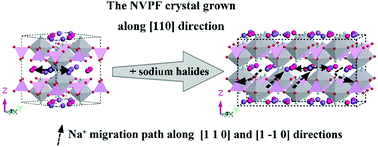Engineering the crystal orientation of Na3V2(PO4)2F3@rGO microcuboids for advanced sodium-ion batteries†
Abstract
Sodium superionic conductor structured Na3V2(PO4)2F3 is demonstrated to be a promising cathode material for sodium-ion batteries (SIBs) due to its high operating potential and robust 3D open framework for fast Na+ migration, but suffers from intrinsic low electronic conductivity caused by the insulating [PO4] tetrahedra. Herein, Na3V2(PO4)2F3@rGO (NVPF@rGO) microcuboids with different exposed crystal facets are fabricated via guiding the crystal growth orientation with the existence of NaX (X = F, Cl, Br). When employed as a cathode for SIBs, the optimum NVPF@rGO electrode exhibits a high discharge capacity of 127.5 mA h g−1 at 0.2C (1C = 128 mA g−1) and impressive rate performance of 73.7 mA h g−1 even at a high rate of 50C. Further testing of the commercial soft carbon//NVPF@rGO full cell delivers relatively excellent electrochemical properties in terms of an average operating voltage of ∼3.3 V, decent cycling stability at 5C (74.5% of the initial capacity after 500 cycles), and high energy density of 338 W h kg−1 (calculated by the mass of the NVPF cathode). Kinetic analysis results reveal that the ameliorated electrochemical properties should be related to the significantly enhanced ion migration at the material/electrolyte interface endowed by the oriented crystal growth along the [110] direction. This work will provide a novel approach for constructing advanced cathode materials for SIBs.

- This article is part of the themed collection: 2020 Materials Chemistry Frontiers HOT articles


 Please wait while we load your content...
Please wait while we load your content...